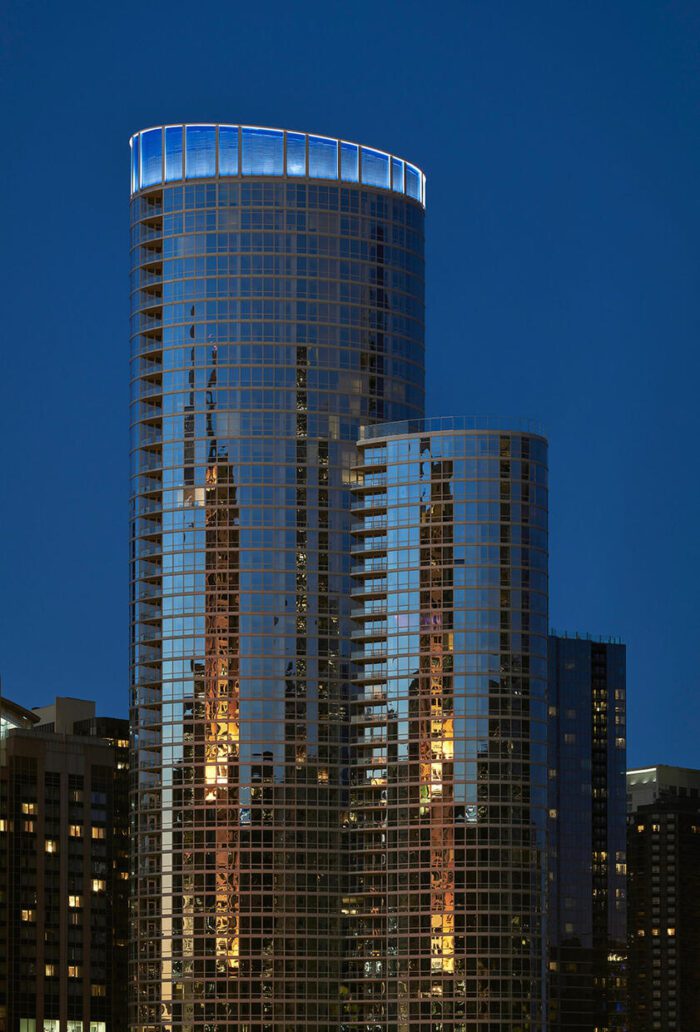
GSW // GLASS UNITS + INSULATING – MEET THE ENERGY CHALLENGE
Green building design isn’t a trend but a movement. The architectural community and the bodies governing codes and standards have grown more aware of the importance of sustainable manufacturing, design and installation of building materials over the decades. That has culminated in innovation in all aspects of the insulating glass unit (IGU). German System Windows can help you take part of one of the greatest innovations!
However, adoption of these codes and products is slow-moving as the industry must contend with budget limitations and higher costs of labor and materials. While the In- ternational Energy Conservation Code and ASHRAE Standard 90.1 are making U-factor adjustments based on climate zone, those changes are incremental.
“Every time you inch down the U-factor an architect needs to adjust its strategy,” explains Helen Sanders, a general manager for Tech- noform North America Inc., based in Twinsburg, Ohio. “If a building is in climate zone 3, for example, a change in U-factor may require that the architect now specify a frame thermal break, or add gas fill to the IGU or add a warm- edge spacer. No code states that a warm-edge spacer should be used, just that the fenestra- tion’s U-factor must be no worse than the re- quired minimum performance. That can be achieved with various strategies.”
On the Edge
Over the years, the glass industry has worked to drive down U-factors through the glass itself. However, a glazing system’s total U-factor is determined by the area-weight av- erage of the frame, edge-of-glass and center- of-glass U-factors.
“Since glass is often the biggest area of the IGU, the effort has focused on driving down the center-of-glass U-factor,” says Sanders. “The industry introduced simple, single sil- ver low-E coatings, then more sophisticated double and triple silver low-E coatings, cavity gas filling and fourth surface low-E coatings. We’ve gone as far as we can get with the center of glass without going to a triple IGU. Now it’s time to look to the edge.”
Aluminum box spacers with dual-seal sili- cone edge seals have dominated the commer- cial market for years. It’s proven to be a durable system because of the effective moisture vapor and gas barrier that a solid metal spacer pro- vides. This is especially important when used with a silicone secondary sealant since sili- cones typically have poor moisture vapor and gas barrier properties compared with other secondary sealants, so the choice of spacer is critical. Silicone also is typically used in com- mercial IGUs because of excellent structural and high-temperature performance and UV and water resistance amid high environmen- tal stresses and loads experienced by IGUs in large commercial applications.
However, heat, like water, finds the path of least resistance to move through a system.
“If you have a frame with no thermal breaks and/or an IGU with an aluminum spacer, heat will flow through the edge. Even if you’re do- ing great things to improve the thermal per- formance of the center of glass, it won’t have the optimum effect if you haven’t managed the thermal transfer at the edge of glass,” says Sanders.
To improve thermal performance, the industry moved from aluminum box spac- ers to box spacers made with stainless steel, which has lower thermal conductivity than aluminum. Sanders explains that it was an easy switch that didn’t impact the system’s durability, yet the thermal performance still wasn’t improved enough. The next step in the evolution of IGU spacers was the hybrid box spacer. These systems were developed in Europe over 20 years ago and were introduced in North America in the mid-2000s. Hybrid box spacers kept the stainless steel around the back and sides where the sealant touches the spacer, meaning the vapor and gas barrier was still a solid metal with no moisture vapor or gas transmission. However, the hybrid spac- er bridged the top with an engineered plastic material, resulting in the path of heat flow be- ing broken by a non-metal. The heat flow path around the back of the spacer was reduced by using thinner stainless steel. According to Sanders, the plastic hybrid stainless steel spacer has the durability performance of the benchmark stainless steel or aluminum box spacer systems, but the thermal performance of a non-metal spacer.
“Stainless steel was a comfortable place because it was similar to the traditional alu- minum box spacers. Ten years ago, if you were talking about warm-edge spacers, an architect might think of stainless steel box spacers. They’re a little warmer and less con- ductive than aluminum spacers,” says Joe Erb, national account manager and commercial sales specialist for Quanex. “If you’re talking about warm-edge in today’s market, an ar- chitect is likely to say stainless steel doesn’t cut it. They’ve definitely evolved over time as true warm-edge products have become more mainstream.”
Brian White is the technical manager for Americas glass at H.B. Fuller, based in St. Paul, Minn. He says the thermoplastic spacer has been one of the biggest evolutions in edge seal technology over the past two decades. In contrast to rigid spacer designs, the ther- moplastic spacer has an inherent elasticity, ensuring lasting durability as performance demands on IGUs continue to increase. “Thermoplastic spacer moves and flexes along with the unit’s daily expansion and con- traction,” adds Jason Douglas, vice president of global window sealants and adhesives for H.B. Fuller. “It performs dynamically, which is especially important for jumbo units as envi- ronmental conditions change.”
Douglas adds that depending on the warm edge spacer used, secondary sealant depths can vary and this affects the overall ther- mal performance and durability of the edge seal. “Some edge designs require more or less secondary sealant to ensure durability, and it’s important to take this into consideration when calculating total product performance,” he says. “TPS contributes to energy efficiency because it keeps the insulating gas where it belongs and glass coatings intact,” says White. “You’re not dealing with losses in thermal efficiency because of gas loss or moisture ingress.”
The U-factor of a high-performance cur- tainwall system with an aluminum box spac- er is 0.33 BTU/°F.hr.ft2. Using a warm-edge spacer brings the U-factor down to around 0.29 BTU/°F.hr.ft2, with thermoplastic, foam, plastic box and plastic hybrid stainless steel box spacers (all types of warm-edge spacers) performing similarly to each other.
“Warm-edge spacers have been in the market for a long time, but it takes a while for new products to get adopted in North Amer- ica. Even today, aluminum is still the most common commercial spacer,” Sanders ex- plains. “We still have a long way to go to drive the market, but I’m optimistic. I’ve seen a sea of change over the last few years where architects are starting to specify it, and many fabricators have a warm-edge spacer option. It’s just a matter of getting architects to spec- ify it over aluminum, which is the cheapest option.”
Erb adds that warm-edge spacers can be applied with automated technology, meaning fewer people are needed to apply the spacer, leading to lower costs, fewer mistakes, greater efficiency and greater output.
“If spacers provide wonderful thermal performance, but they’re too complicated to manufacture or install, adoption will be low,” says Erb. “The market constantly looks for simplicity. You can simplify manufacturing with automation. However, skilled labor is still needed to operate the programs and ma- chines involved.”
Durability Equals Sustainability
Much of the discussions around sustain- ability in glazing have focused on operation- al carbon, or a building’s carbon emissions during its operation. In the past, higher en- ergy usage translated to higher carbon. As grids become greener, that correlation isn’t as strong, shifting the focus to embodied carbon, or the greenhouse gas emissions arising from the manufacturing, transportation, installa- tion, maintenance and disposal of building materials.
“If you look at an IGU, the majority of the embodied carbon comes from the glass lites. The edge materials make up approximately 5% of the system’s total embodied carbon,” says Sanders. “When we think about embod- ied carbon, we have to think about the dura- bility of an IGU because we want to make sure we’re getting the longest use out of the flat glass embodied carbon emissions. If we have to change a unit every five years, that’s a lot of additional embodied carbon over the lifetime of the building, so durability of the edge seal becomes key.”

Erb points out that sustainability programs such as LEED and Passive House emphasize the importance of durability.
“They don’t just want a good performance number. The product also needs to last,” he says. It’s crucial that thermal performance doesn’t come at the cost of durability. Sanders points out that more recently in Europe, the glass industry has used a dematerialization strategy for the spacer, replacing the metal barrier, to get incrementally better thermal performance.
“Because of how the European U-factor standards are written, they think about the edge, frame and center of glass separately, focusing on the performance of the individual element. In some respects, this ends up with a better-balanced window,” she says. “However, you can end up removing materials on the edge of glass to reduce edge-of-glass U-factor and lose sight of the fact that at a certain point those changes don’t make that much difference in the overall fenestration U-factor. A 10% improvement in the edge of glass thermal performance may seem great in isolation, but with the weighted average, it doesn’t have as big an impact. We have to be careful that we’re not sacrificing durability for thermal performance. The challenge is in extending the life of the IGU.”
The Sealant Story
There are two types of sealants currently in the market: standard modulus and high modulus. High modulus silicone sealants are stronger and less elastic. Therefore, they help protect the primary seal over a long period of time in addition to improving argon retention, according to Jim Blamble, key account man- ager for Sika Corp, based in Lyndhurst, N.J.
“High modulus silicone sealants are less elastic and have a structurally higher tensile strength. In the cases of unitized curtainwall where you might require a larger bead of sil- icone on the IGU, you can effectively reduce the bead size by about a third in most cases,” he explains.
The result is that the frame depth can be reduced, increasing the amount of daylight that can pass through the system. This can help re- duce operational costs and energy since less lighting is needed.
Douglas adds that depending on the warm edge spacer used, it might demand a particular sealant depth for durability.
“The less sealant you put on, the more energy efficient the unit is going to be because it doesn’t have the thermal conductivity of the sealant, and you can move the seal closer to the edge,” he says.
Blamble also points out that silicone seal- ants usually have low volatile organic com- pounds (VOC), which is a consideration by organizations such as LEED when considering a product’s sustainability.
 Configuration Considerations
Configuration Considerations
IGU configurations such as triple-pane IGUs or triples with one lite of glass being vacuum insulating glass, are thermal efficient options available in North America, in addi- tion to the developing field of photovoltaics. However, these systems are more expensive, and adoption is still low. Erb expects to see the specification of triple IGUs grow in the commercial and residential market. He points out that with thinner framing systems and larger glass lites, the frame still needs to be able to handle the size and weight of the addition- al glass, and composite materials in framing with a true warm-edge spacer help lessen the weight of the overall system. The silicone bead should also be an appropriate size for the system to manage the IGU’s heavier weight with more glass and a thicker frame.
In many markets where energy codes are more stringent, such as the Northeast and Northwest, the window-to-wall ratios are becoming more challenging, with punched openings growing in use. Erb says this has given Quanex the opportunity to use vinyl (e.g. rigid PVC, uPVC) in commercial build- ings with punched openings and window walls. Vinyl also gives architects expanding color options, and these systems can have a U-factor of 0.26 or lower with a traditional dual pane IG. The framing is fusion-welded and provides an additional level of protection from air and water compared to mechanically joined and fastened frames sealed with sili- cone. Erb says that while the commercial in- dustry is still working toward a broader adop- tion of vinyl across the spectrum, it’s gaining traction. Blamble says he’s seen more use of composite box spacers.
There have been developments on the edge where the metal in a hybrid spacer is replaced with metalized plastic foil to incre- mentally improve the edge of glass U-factor. Those typically are not recommended to be used in combination with silicone secondary sealants, though, because it doesn’t have the same barrier properties as a hybrid spacer, ac- cording to Sanders.
She warns that specifiers should be careful when bringing in products from Europe be- cause the edge seal systems there are differ- ent, especially the sealant types, which may have different moisture vapor and gas trans- mission than the silicone sealants commonly used in North America.

Additionally, components can’t just be in- terchanged and expected to work as intended. Any new component and sealant combina- tions must be tested and evaluated to ensure a durable edge seal.
“Always test based on job-specific condi- tions. That is the fail-safe,” says Blamble.
Post by Jordan Scott / USGlass Metal & Glazing
Let’s create the building of your dreams. Contact us on our website and let’s chat. germansystemwindows.com

 Configuration Considerations
Configuration Considerations






